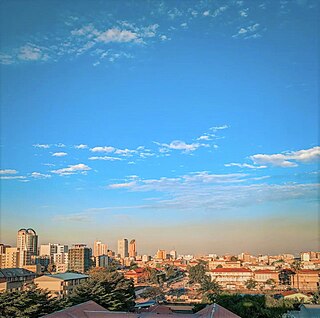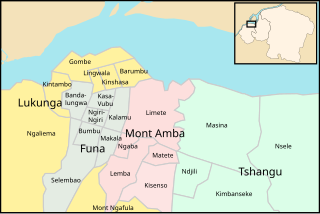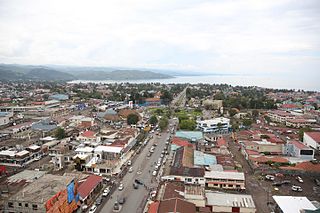
Kinshasa, formerly named Léopoldville until 30 June 1966, is the capital and largest city of the Democratic Republic of the Congo. Once a site of fishing and trading villages along the Congo River, Kinshasa is now one of the world's fastest-growing megacities. Kinshasa's 2024 population was estimated at 17,032,322. It is the most densely populated city in the DRC, the most populous city in Africa, the world's fourth-most-populous capital city, Africa's third-largest metropolitan area, and the leading economic, political, and cultural center of the DRC. Kinshasa houses several industries, including manufacturing, telecommunications, banking, and entertainment. The city also hosts some of DRC's significant institutional buildings, such as the Palais du Peuple, Palais de la Nation, Court of Cassation, Constitutional Court, Cité de l'Union Africaine, Palais de Marbre, Stade des Martyrs, Immeuble du Gouvernement, Kinshasa Financial Center, and multiple federal departments and agencies.

Mont Ngafula, or Mont-Ngafula, is a commune in the Lukunga District of Kinshasa, in the western part of the Democratic Republic of the Congo. By its surface area, Mont Ngafula is the third-largest commune in Kinshasa's city-province. It is located in the hilly southern area of Kinshasa and is intersected by the Lukaya River valley in its southern portion. The boundary with the Ngaliema commune is defined by the Lukunga River. Mont Ngafula shares borders with the Makala commune to the north, the Kongo Central Province to the south, the Lemba and Kisenso communes to the east, and the Selembao commune to the west. It has an estimated population of 718,197 (2015).

Bandalungwa is a commune in the Funa District of Kinshasa in the western region of the Democratic Republic of the Congo. Covering an area of 6.82 square kilometers, Bandalungwa is centrally situated within the city. It is bordered by the Gombe commune and the Kokolo military barracks to the north, Selembao to the south, the communes of Ngiri-Ngiri, Kasa-Vubu, and Lingwala to the east, and the Makelele River, Ngaliema, and Kintambo to the west. The commune had an estimated population of 934,821 in 2015, although official census data from 2016 reported a significantly lower figure of 259,760 residents.

Barumbu is a commune in the Lukunga District of Kinshasa, located strategically in the northern region of the city. As of 2015, Barumbu had an estimated population of 413,628, making it one of Kinshasa's more densely populated communes.

Gombe, also known as La Gombe, or Downtown Kinshasa, is one of the 24 communes of Kinshasa, in the western part of the Democratic Republic of the Congo. Encompassing a vast area of approximately 29.33 square kilometers, it is home to an approximate population of 49,024 residents (2014).

Kalamu is a commune in the Funa District of Kinshasa, located in the western region of the Democratic Republic of the Congo. Covering an area of 6.64 square kilometers, Kalamu lies in the central part of the city-province of Kinshasa. It is bordered by the Kinshasa commune to the north, Makala to the south, and Limete to the east, with Avenue de l'Université marking the boundary. As of 2015, Kalamu had an estimated population of 974,669, while a 2020 estimate noted a decrease to 208,155.

The University of Kinshasa, colloquially known by its acronym UNIKIN, is a public university located in Kinshasa's Lemba commune within the western region of the Democratic Republic of the Congo. It is the country's premier university. Initially established in 1954 as Lovanium University during Belgian colonial rule, the current university was established following the division of the National University of Zaire (UNAZA) in 1981.

Selembao is one of the 24 communes that are the administrative divisions of Kinshasa, the capital city of the Democratic Republic of the Congo. Covering over 12 square kilometers and with an estimated population of 1,038,819 as of 2015, it is bordered to the north by the communes of Bandalungwa and Bumbu, to the northeast by Bumbu, to the south by Mont Ngafula, to the east by Makala, and to the west by Ngaliema.

The Régie de Distribution d'Eau, abbreviated as REGIDESO, is a state-owned utility company located on Boulevard Du 30 Juin, in the Gombe commune of Kinshasa, Democratic Republic of the Congo (DRC). It is responsible for producing and distributing water throughout the national territory, encompassing both urban and rural areas. Established in 1929, REGIDESO operates autonomously under the oversight of the Ministry of Energy and the Portfolio.

Kintambo is a municipality (commune) in the Lukunga district of Kinshasa, the capital city of the Democratic Republic of the Congo.

Makala is a commune located in the Funa District of Kinshasa, the capital city of the Democratic Republic of the Congo. Covering an area of 5.60 square kilometers, Makala is situated in Kinshasa's southern hilly region and has an estimated population of 698,495 as of 2015.

Lemba is a commune in the Mont Amba District of Kinshasa, the capital of the Democratic Republic of the Congo. Spanning an area of 23.70 square kilometers, it has an estimated population of 1,120,992 as of 2015. Lemba is bordered by several communes, with the Limete commune to the north, the Kalamu River forming a natural boundary with Ngaba to the northwest, and Makala to the southwest. The Kimwenza road marks its border with Mont-Ngafula, while the Matete River separates it from Matete to the northeast and Kisenso to the southeast.

Limete is one of the 24 communes that are the administrative divisions of Kinshasa, the capital city of the Democratic Republic of the Congo.

Matete is one of the 24 communes of Kinshasa, the capital city of the Democratic Republic of the Congo. Situated in the Mont Amba District in the southern part of Kinshasa, Matete spans an area of 4.80 square kilometers and had an estimated population of 854,908 as of 2015. It shares borders with the communes of Lemba and Limete to the north, Kisenso to the south, N'djili to the east, and Lemba to the west.

Mont Amba is an area of the capital city of Kinshasa, Democratic Republic of the Congo, comprising five of the city-province's twenty-four administrative divisions—the communes of Kisenso, Lemba, Limete, Matete and Ngaba. It is one of the four so-called districts of Kinshasa. These were the administrative divisions of Kinshasa during much of the Mobutu years (1965-1997) and around which a number of government systems and services are still organized. For instance, Mont Amba makes up an eleven-member National Assembly constituency designated as Kinshasa III. However, these districts are not part of Congo's territorial organization.
The University of Kikwit (UNIKI) is a public university in the Democratic Republic of the Congo, located in the province of Bandundu, city of Kikwit. At its creation, it was an Extension of the University of Kinshasa, then called University Centre of Kikwit (CUK). As of 2012, instruction is in French.

Goma is a commune of the city of Goma in the North Kivu Province of the eastern region of the Democratic Republic of the Congo. It encompasses the southernmost sector of the city, extending from the principal main road towards the shores of Lake Kivu. As per a 2018 estimate, the commune had approximately 333,727 residents.

Héritier Bondongo Kabeya, known professionally as Héritier Watanabe or simply Héritier Wata, is a Congolese singer, songwriter, dancer, producer, and bandleader. He is the founder of the Kinshasa-based orchestra Team Wata. An influential figure in fifth-generation Congolese rumba, Kabeya began singing at 10 years old and soon joined JB Mpiana's Wenge BCBG for practice and public appearances, seeking membership but was eventually repudiated.
University Avenue is a prominent north–south road in Kinshasa, Democratic Republic of the Congo. Serving as one of the city's main traffic arteries, it spans the urban area from its northern terminus at the intersection of Sendwe Avenue and Lumumba Boulevard—marking the boundary between the communes of Kalamu and Limete—to its southern end at the University of Kinshasa campus in the commune of Lemba. Along its route, the avenue intersects major roads such as Victoire Avenue, Bongolo Avenue, Yolo Avenue, and Kapela Avenue, while passing key landmarks including the Ezo Roundabout and the Ngaba Roundabout, where it separates the communes of Makala and Ngaba.
The Ngaba Roundabout, also referred to as the Ngaba Crossroads, is a significant intersection in the southern part of Kinshasa, Democratic Republic of the Congo. Situated in the Mount Amba District, it marks the southern boundary of the Ngaba commune and lies at the convergence of Avenue de l'Université and By-pass Avenue. The area surrounding the roundabout is locally referred to as Mont-Amba and serves as a key hub connecting the communes of Lemba and Makala.

















